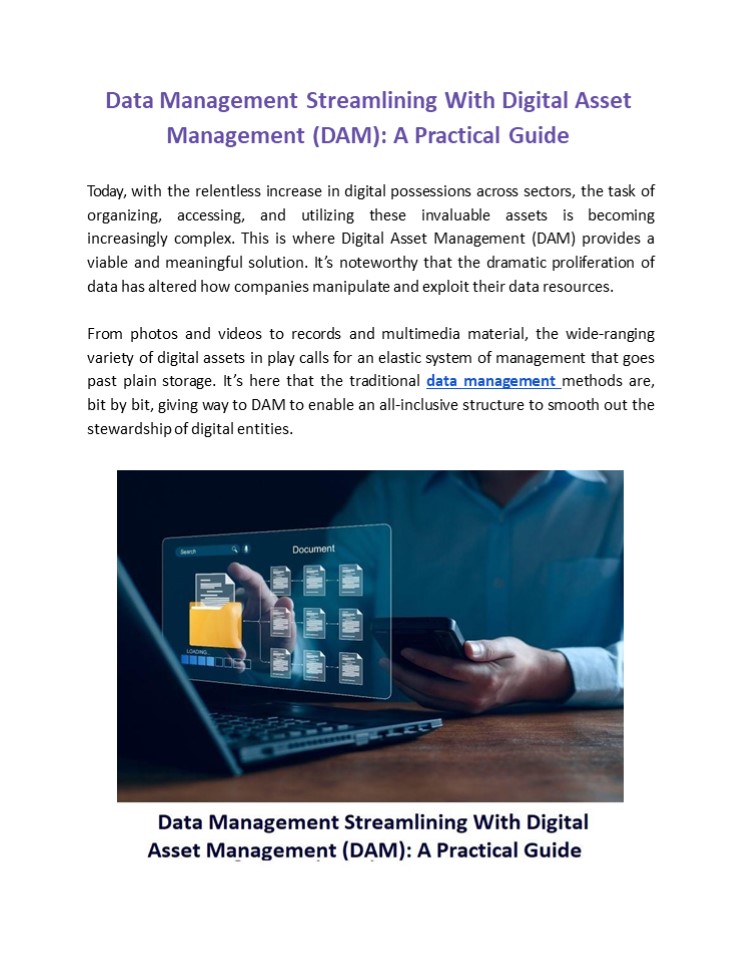Data Management Streamlining with Digital Asset Management (DAM): A Practical Guide
Title:
Data Management Streamlining with Digital Asset Management (DAM): A Practical Guide
Description:
EnFuse emerges as a guiding light in the world of DAM. With their expertise and practical approach, they not only alleviate the complexities of asset management but elevate your brand’s potential across various channels. Connect with them today and observe how their DAM proficiency can revolutionize your brand’s digital asset management. –
Number of Views:2
Title: Data Management Streamlining with Digital Asset Management (DAM): A Practical Guide
1
Data Management Streamlining With Digital Asset
Management (DAM) A Practical Guide
Today, with the relentless increase in digital
possessions across sectors, the task of
organizing, accessing, and utilizing these
invaluable assets is becoming increasingly
complex. This is where Digital Asset Management
(DAM) provides a viable and meaningful solution.
Its noteworthy that the dramatic proliferation
of data has altered how companies manipulate and
exploit their data resources. From photos and
videos to records and multimedia material, the
wide-ranging variety of digital assets in play
calls for an elastic system of management that
goes past plain storage. Its here that the
traditional data management methods are, bit by
bit, giving way to DAM to enable an all-inclusive
structure to smooth out the stewardship of
digital entities.
2
- In this article, we look into the universe of DAM
to unveil its value, advantages, and
applications bringing to light how this
advanced practice holds the answer to proficient
and effective data control. - What Is Digital Asset Management (DAM)?
- Digital Asset Management (DAM) is a structured
and technical solution designed to amass,
arrange, and enhance the handling of a companys
digital resources or assets. Such assets
encompass a broad scope of digital documents,
photos, recordings, audio, papers,
demonstrations, and additional multimedia
material. - The purpose of DAM is to deliver a hassle-free
and logical means of storing, accessing,
dispersing, and circulating these items among
teams, subdivisions, and even external
associates. At its core, DAM serves as a complex
database for storing digital assets. It
categorizes them with metadata, which consists of
various aspects such as the assets title,
description, author, date of creation, usage
rights, and keywords. - This careful categorization streamlines finding
assets in the system and avoiding long,
exhausting search through multiple folders and
drives. DAM systems often have advanced search
functions that make it easy to retrieve assets
when certain criteria are met or by typing out
certain keywords. - What Are The Benefits Of Implementing DAM?
- The implementation of DAM provides multiple
advantages that are applicable to many aspects
of an enterprises activities. Heres a rundown - Enhanced asset organization and accessibility
- Time and cost savings
- Enhanced security
- Analytics and insights
3
- Reduced redundancy and asset wastage
- Enhanced internal and external collaboration over
assets - Compliance with copyright laws
- What Are The Core Features Of An Effective DAM
System? - A well-structured DAM system is designed to
fulfill the multifaceted needs of modern
businesses, streamlining data organization and
amplifying the usefulness of digital resources.
Here are the top 7 most important features to
keep an eye out for - User Experience (UX)
- A seamless and intuitive user experience (UX)
lies at the heart of successful DAM. A
well-crafted UX ensures that users can
effortlessly navigate through the solution,
locate their desired assets promptly, and engage
in productive collaborations. Intuitive
interfaces, smart search capabilities, and easily
customizable features simplify the users
journey, saving time and minimizing
frustrations. - Integration Capabilities
- A comprehensive Digital Asset Management (DAM)
system efficiently merges with a wide range of
other enterprise platforms and tools, including
Content Management Systems (CMSs), project
administration software, etc. This amalgamation
makes processes far more manageable and
guarantees that resources can be obtained and
utilized whenever required. - Storage And Capacity
4
- A sound DAM structure needs abundant storage and
capacity. Particularly in todays world, where
digital material is being produced at a breakneck
rate, a flexible and methodically planned
storage framework is critical. - Having an advanced DAM arrangement should provide
not merely for existing materials but also allow
effortless augmentation as the digital asset
catalog continues to develop. This guarantees
that your organization can regulate, access, and
allocate assets in an efficient manner devoid of
any storage restrictions. - Automation
- Robust digital asset management fuses automation
technologies that facilitate workflows from
asset acquisition to circulation. Thanks to
metadata tagging, auto-classification, and
intelligent indexing, automation assures that
assets are quickly cataloged, labeled, and
rendered attainable. - This not only accelerates hunt and retrieval but
also boosts content recognizability.
Additionally, automation helps to ensure
uniformity across branding and material
utilization by enforcing previously defined
endorsement methods and asset administration. - Shareability
- DAM should provide users with the capacity to
effortlessly share digital materials and
resources. Seamless sharability not only
simplifies workflows but also supports
partnership and encourages collaborative work.
Therefore, a DAM setup should have accessible
sharing tools that can empower users to customize
permission policies. - Manage Your Brand Assets The Right Way With EnFuse
5
All in all, organizations can substantially
advance their operations by having a concrete
digital asset management solution in place. As
the role of digital assets continues to evolve,
it becomes critical for enterprises to
implement. A DAM solution that can help them
better organize content, streamline
workflows, minimize compliance risks, better
allocate resources, and introduce digital asset
transparency. EnFuse emerges as a guiding light
in the world of DAM. With our expertise and
practical approach, we not only alleviate the
complexities of asset management but elevate
your brands potential across various channels.
From reviewing existing DAM solutions and
troubleshooting DAM initiatives to data cleansing
and metadata management, we can help enterprises
take control of their digital assets. Connect
with us today and observe how our DAM proficiency
can revolutionize your brands digital asset
management. Read More Product Data Is The
Cornerstone Of B2B eCommerce































